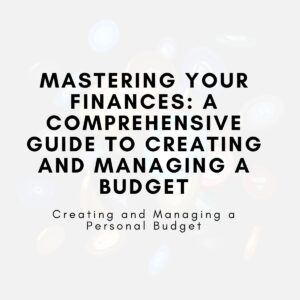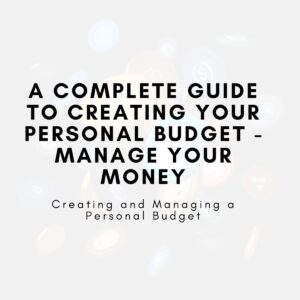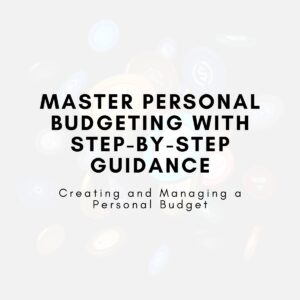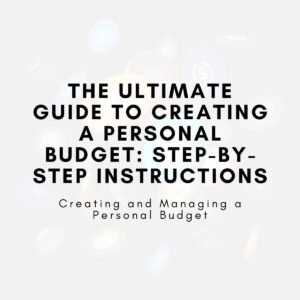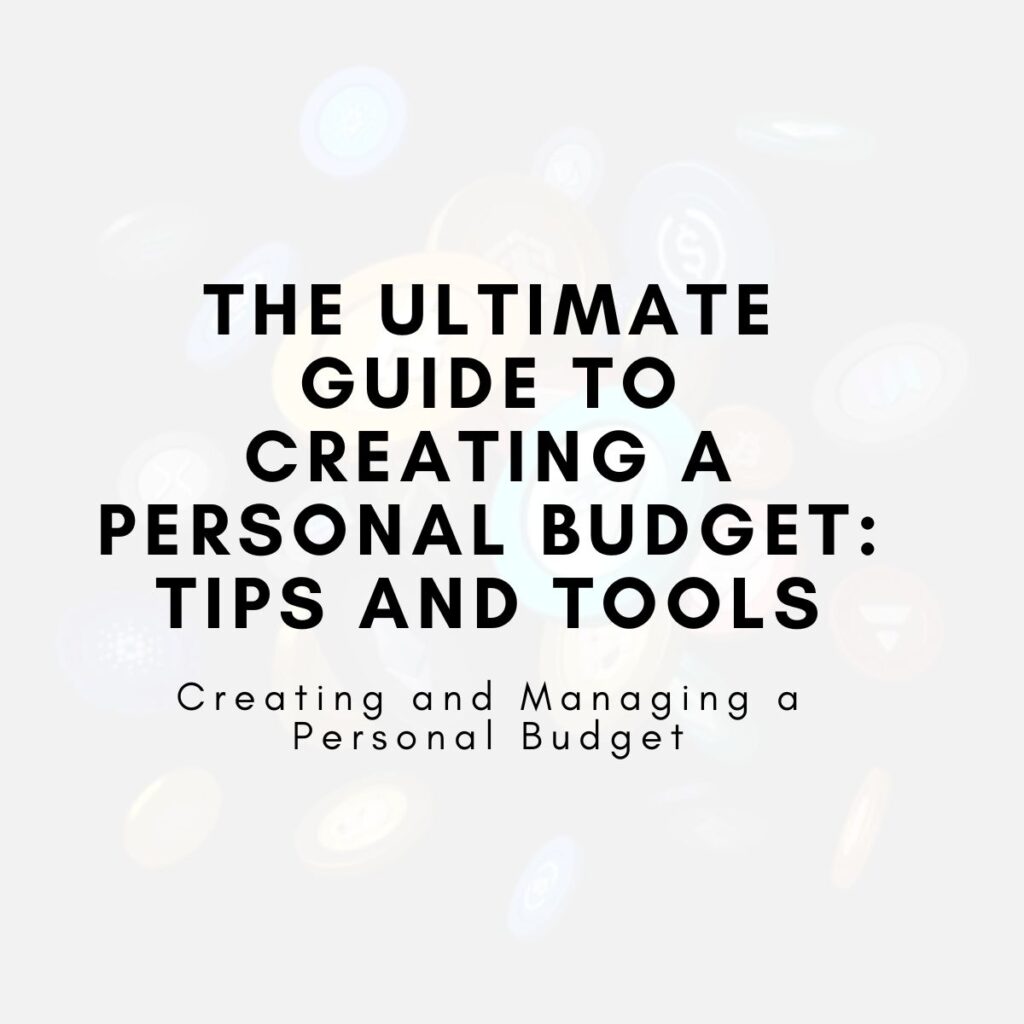
Why creating a personal budget is essential ?
Creating a personal budget is essential for achieving financial freedom and ensuring your spending aligns with your financial goals. Mastering personal budgeting is the key to achieving financial independence and reducing money-related stress. This ultimate guide provides expert tips, proven methods, and the best tools to create a personal budget that works for you, empowering you to take charge of your financial future.
Introduction
Budgeting is one of the most empowering financial habits you can adopt. It provides a clear view of your financial health and ensures that every dollar you earn serves a purpose. Despite its importance, many people find budgeting intimidating or tedious. However, the rewards of effective budgeting far outweigh the effort required to establish and maintain it.
This guide is designed to demystify budgeting and make it accessible to everyone. From understanding the basics to exploring advanced strategies and tools, this comprehensive resource will equip you with everything you need to take control of your finances. Whether you’re starting your financial journey or refining an existing budget, this guide will help you achieve financial stability and confidence.
What Is a Personal Budget and Why Is It Important?
A personal budget is more than just a record of income and expenses; it is a financial strategy that enables you to plan and prioritize your spending. By creating a budget, you ensure that your money works for you rather than the other way around. At its core, budgeting is about making intentional financial decisions that align with your short-term needs and long-term aspirations.
Why Budgeting Matters
The importance of budgeting cannot be overstated. It serves as a roadmap for your financial journey, guiding you toward your goals while helping you avoid pitfalls like debt accumulation or overspending. With a budget, you gain clarity about where your money goes, allowing you to identify wasteful spending and redirect funds to areas that matter most.
Additionally, a budget is an essential tool for building wealth and achieving financial security. It enables you to allocate resources for savings, investments, and debt repayment, all while maintaining control over day-to-day expenses. Over time, these disciplined practices can lead to significant improvements in your financial well-being.
Steps to Create an Effective Budget
Step 1: Assess Your Financial Situation
The first step in creating a budget is understanding your current financial standing. Start by gathering all relevant financial information, such as your income, monthly expenses, debts, and savings. A clear picture of your financial situation will provide the foundation for building a realistic and effective budget.
To begin, calculate your total monthly income. This includes not only your salary but also any additional sources of income, such as freelance work, rental income, or dividends from investments. Be sure to use post-tax figures for accuracy. Next, analyze your expenses. Divide them into fixed costs (e.g., rent, utilities) and variable costs (e.g., groceries, entertainment). Lastly, review your debts and savings to understand your financial obligations and progress toward your goals.
Step 2: Define Your Financial Goals
Budgeting without goals is like navigating without a destination. Your financial goals give your budget purpose and direction. Start by identifying what you want to achieve in the short term (within a year) and the long term (beyond five years).
For example, short-term goals might include building a $1,000 emergency fund, paying off a credit card, or saving for a vacation. Long-term goals could involve purchasing a home, saving for retirement, or funding your child’s education. To increase your chances of success, ensure that your goals are SMART: Specific, Measurable, Achievable, Relevant, and Time-bound. For instance, instead of saying, “I want to save money,” aim for, “I will save $5,000 for a car over the next 12 months by setting aside $417 monthly.”
Step 3: Choose a Budgeting Method
There are several budgeting methods to choose from, each catering to different financial needs and personality types.
- The 50/30/20 Rule: Allocate 50% of your income to necessities, 30% to discretionary spending, and 20% to savings and debt repayment. This method is simple and ideal for beginners.
- Zero-Based Budgeting: Assign every dollar a job, ensuring your income minus expenses equals zero. This approach offers precise control over your finances.
- The Envelope System: Physically separate your money into envelopes for specific categories like groceries, entertainment, or dining out. This method helps curb overspending.
- Pay-Yourself-First Budgeting: Prioritize savings and investments by setting aside a predetermined amount before addressing other expenses. This strategy is excellent for saving-focused individuals.
Step 4: Track and Adjust Your Spending
A budget is not a set-it-and-forget-it tool. To ensure its effectiveness, you must consistently track your spending and make adjustments as needed. Start by monitoring your expenses daily or weekly using a budgeting app, spreadsheet, or notebook. Compare your actual spending against your budgeted amounts to identify discrepancies and make corrections.
Life is dynamic, and your budget should reflect those changes. If your income increases, for instance, consider allocating more toward savings or debt repayment. Conversely, if unexpected expenses arise, adjust your budget to accommodate them while staying within your financial limits.
Tools and Resources for Budgeting
The right tools can simplify the budgeting process and make it easier to stay on track.
Popular Budgeting Apps
- Mint: A free app that syncs with your bank accounts to track income and expenses automatically. Mint categorizes your spending and provides personalized tips for saving money.
- YNAB (You Need A Budget): This app is perfect for those who want to give every dollar a job. YNAB encourages proactive budgeting and helps users save more effectively.
- PocketGuard: This app calculates how much disposable income you have after accounting for bills, goals, and necessities.
Traditional Methods
If you prefer a hands-on approach, consider these traditional budgeting tools:
- Spreadsheets: Tools like Microsoft Excel or Google Sheets allow you to customize your budget and analyze data in detail.
- Pen and Paper: A simple notebook can be a powerful tool for tracking income and expenses manually.
Automation Tools
- Set up automatic bill payments to avoid late fees and simplify recurring expenses.
- Schedule automatic transfers to savings accounts or investment funds to ensure consistent contributions.
Overcoming Common Budgeting Challenges
While budgeting can transform your financial life, it’s not without challenges. Here’s how to tackle some common obstacles:
1. Irregular Income
Many freelancers and gig workers struggle with unpredictable earnings. To overcome this, create a budget based on your lowest expected monthly income. Use months with higher earnings to build an emergency fund or pay off debts.
2. Overspending on Wants
Impulse purchases can derail even the best budgets. Combat this by implementing a 24-hour rule: wait a day before making non-essential purchases. Additionally, limit discretionary spending by using cash or preloaded cards.
3. Forgetting Irregular Expenses
Annual or semi-annual costs, such as car insurance or holiday shopping, are easy to overlook. Plan for these by creating a sinking fund—a separate account where you save small amounts monthly for upcoming expenses.
4. Lack of Motivation
Budgeting can feel monotonous over time. Stay motivated by revisiting your goals regularly and celebrating milestones, such as paying off a loan or hitting a savings target.
The Psychological Benefits of Budgeting
Beyond its financial advantages, budgeting also improves your mental well-being. It reduces financial anxiety by giving you a clear understanding of your money and ensures you are prepared for unexpected expenses.
Budgeting fosters discipline and self-control, which can positively impact other areas of your life. By prioritizing needs over wants, you develop habits that promote long-term success. Finally, achieving financial goals—whether it’s paying off a debt or saving for a vacation—boosts your confidence and inspires you to aim higher.
Conclusion
Budgeting is not just about crunching numbers—it’s about taking charge of your life and shaping your future. By following the steps outlined in this guide, you can create a budget that reflects your priorities and sets you on a path to financial independence.
Whether you’re new to budgeting or looking to refine your approach, remember that consistency and adaptability are key. Regularly review your budget, make adjustments as needed, and celebrate every financial milestone along the way. With determination and the right tools, you can transform your financial habits and achieve the stability and freedom you desire.
Key Takeaways
- A personal budget is a financial plan that aligns your income, expenses, savings, and goals.
- Budgeting methods like the 50/30/20 rule, zero-based budgeting, and the envelope system cater to different needs.
- Tools like Mint, YNAB, and spreadsheets simplify the budgeting process and help you stay organized.
- Address challenges like irregular income and forgotten expenses with proactive strategies like sinking funds and automation.
- Budgeting improves not only your finances but also your mental well-being by reducing stress and fostering confidence.

